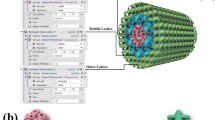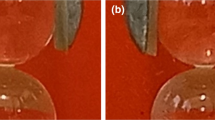Abstract
The excellent mechanical properties of nacre have attracted the research interest of countless scholars and inspired the optimal design of novel nacre-like materials. In recent years, studies have found that the interface between the mineral platelet and the organic layer of nacre has an uneven micro-topological structure, which has an interlocking effect during the deformation process, and plays a vital role in the mechanical response of nacre. The interlocking structure can increase the sliding resistance of the platelets to increase the fracture toughness. Based on this mechanism, we adapted a crack-bridging model to elucidate the influence of the interlocking angle on the fracture toughness and crack-bridging toughening effect of nacre. The critical interlocking angle and fracture toughness calculated by this model are consistent with the observed and actual experimental results in nacre. This model is of great significance for guiding the interface interlocking design of novel nacre-like materials.






Similar content being viewed by others
References
Emery, Z.L., Vlasta, N.L.: The evolution of brittle fracture in rocks. J Geol Soc Lond 130, 1–16 (1974)
Zhao, Y.L., Wang, Y.X., Wang, W.J., et al.: Modeling of rheological fracture behavior of rock cracks subjected to hydraulic pressure and far field stresses. Theor. Appl. Fract. Mech. 101, 59–66 (2019)
Zhao, Y.L., Zhang, L.Y., Asce, F., et al.: Experimental study of fracture toughness and subcritical crack growth of three rocks under different environments. Int. J. Geomech. 20(8), 04020128 (2020)
Meyers, M.A., McKittrick, J., Chen, P.Y.: Structural biological materials: critical mechanics-materials connections. Science 339, 773–779 (2013)
Sarikaya, M., Gunnison, K.E., Yasrebi, M., et al.: Mechanical property-microstructural relationships in abalone shell. Mater. Res. Soc. Symp. Proc. 174, 109–116 (1989)
Li, X.D., Chang, W.C., Chao, Y.J., et al.: Nanoscale structural and mechanical characterization of a natural nanocomposite material: the shell of red abalone. Nano. Lett. 4, 613–617 (2004)
Oaki, Y., Imai, H.: The hierarchical architecture of nacre and its mimetic material. Angew. Chem. Int. Ed. 117, 6571–6575 (2010)
Jackson, A.P., Vincent, J., Turner, R.M.: The mechanical design of nacre. Proc. R. Soc. Lond. B 234, 415–440 (1988)
Mayer, G.: Rigid biological systems as models for synthetic composites. Science 310, 1144–1147 (2005)
Espinosa, H.D., Rim, J.E., Barthelat, F., et al.: Merger of structure and material in nacre and bone—perspectives on de novo biomimetic materials. Prog. Mater. Sci. 54, 1059–1100 (2009)
Kamat, S., Su, X., Ballarini, R., et al.: Structural basis for the fracture toughness of the shell of the conch Strombus gigas. Nature 405, 1036–1040 (2000)
Ji, B.H., Gao, H.J.: Mechanical properties of nanostructure of biological materials. J. Mech. Phys. Silids 52, 1963–1990 (2004)
Barthelat, F., Rabiei, R.: Toughness amplification in natural composites. J. Mech. Phys. Solids 59, 829–840 (2011)
Launey, M.E., Ritchie, R.O.: On the fracture toughness of advanced materials. Adv. Mater. 21, 2103–2110 (2009)
Bao, G., Suo, Z.: Remarks on crack-bridging concepts. Appl. Mech. Rev. 45, 355–366 (1992)
Bao, G., Song, Y.: Crack bridging models for fiber composites with slip-dependent interfaces. J. Mech. Phys. Solids 41, 1425–1444 (1993)
Shao, Y., Zhao, H.P., Feng, X.Q., et al.: Discontinuous crack-bridging model for fracture toughness analysis of nacre. J. Mech. Phys. Solids 60, 1400–1419 (2012)
Shao, Y., Zhao, H.P., Feng, X.Q.: On flaw tolerance of nacre: a theoretical study. J. R. Soc. Interface 11, 20131016 (2014)
Barthelat, F., Espinosa, H.D.: An experimental investigation of deformation and fracture of nacre–mother of pearl. Exp. Mech. 47, 311–324 (2007)
Katti, K.S., Katti, D.R., Pradhan, S.M., et al.: Platelet interlocks are the key to toughness and strength in nacre. J. Mater. Res. 20, 1097–1100 (2005)
Espinosa, H.D., Juster, A.L., Latourte, F.J., et al.: Tablet-level origin of toughening in abalone shells and translation to synthetic composite materials. Nat. Commun. 2, 1–9 (2011)
Rabiei, R., Bekah, S., Barthelat, F.: Failure mode transition in nacre and bone-like materials. Acta Biomater. 6, 4081–4089 (2010)
Barthelat, F., Tang, H., Zavattieri, P., et al.: On the mechanics of mother-of-pearl: a key feature in the material hierarchical structure. J. Mech. Phys. Solids 55, 306–337 (2007)
Al-Maskari, N.S., Mcadams, D.A., Reddy, J.N.: Modeling of a biological material nacre: waviness stiffness model. Mater. Sci. Eng. C 70, 772–776 (2017)
Al-Maskari, N.S., Mcadams, D.A., Reddy, J.N.: Modeling of a biological material nacre: waviness toughness model. Mech. Adv. Mater. Struct. 26, 789–795 (2019)
Ghazlan, A., Ngo, T.D., Tran, P.: Influence of interfacial geometry on the energy absorption capacity and load sharing mechanisms of nacreous composite shells. Compos. Struct. 132, 299–309 (2015)
Cui, S.K., Lu, Z.X., Yang, Z.Y.: Effect of interlocking structure on mechanical properties of bio-inspired nacreous composites. Compos. Struct. 226, 111260 (2019)
Cui, S.K., Lu, Z.X., Yang, Z.Y.: An analytical model for the bio-inspired nacreous composites with interlocked “brick-and-mortar” structures. Compos. Sci. Technol. 193, 108131 (2020)
Liu, F., Li, T.T., Jia, Z., et al.: Combination of stiffness, strength, and toughness in 3D printed interlocking nacre-like composites. Extrem. Mech. Lett. 35, 100621 (2019)
Valashani, S.M.M., Barthelat, F.: A laser-engraved glass duplicating the structure, mechanics and performance of natural nacre. Bioinspir. Biomim. 10, 026005 (2015)
Yao, H.M., Song, Z.G., Xu, Z.P., et al.: Cracks fail to intensify stress in nacreous composites. Compos. Sci. Technol. 81, 24–29 (2013)
Budiansky, B., Amazigo, J.C.: Toughening by aligned, frictionally constrained fibers. J. Mech. Phys. Solids 37, 93–109 (1989)
Meyers, M.A., Lim, C.T., Li, A., et al.: The role of organic intertile layer in abalone nacre. Mater. Sci. Eng. C 29, 2398–2410 (2009)
Wang, R.Z., Gupta, H.S.: Deformation and fracture mechanisms of bone and nacre. Annu. Rev. Mater. Res. 41, 41–73 (2011)
Song, F., Bai, Y.L.: Effects of nanostructures on the fracture strength of the interfaces in nacre. J. Mater. Res. 18, 1741–1744 (2003)
Barthelat, F., Li, C.M., Comi, C., et al.: Mechanical properties of nacre constituents and their impact on mechanical performance. J. Mater. Res. 21, 1977–1986 (2006)
Meyers, M.A., Chen, P.Y., Lin, Y.M., et al.: Biological materials: structure and mechanical properties. Prog. Mater. Sci. 53, 1–206 (2008)
Fleischli, F.D., Dietiker, M., Borgia, C., et al.: The influence of internal length scales on mechanical properties in natural nanocomposites: a comparative study on inner layers of seashells. Acta Biomater 4, 1694–1706 (2008)
Acknowledgements
The authors are grateful to the support by the National Natural Science Foundation of China (NSFC) under Grant Nos. 1177220 and 12021002
Author information
Authors and Affiliations
Corresponding author
Ethics declarations
Conflict of interest
The authors declare that they have no conflict of interest.
Additional information
Publisher's Note
Springer Nature remains neutral with regard to jurisdictional claims in published maps and institutional affiliations.
Rights and permissions
About this article
Cite this article
Ge, Yj., Huang, Gy. A mechanical model of the crack-bridging effect in nacre with interlocking interface. Arch Appl Mech 92, 151–162 (2022). https://doi.org/10.1007/s00419-021-02046-5
Received:
Accepted:
Published:
Issue Date:
DOI: https://doi.org/10.1007/s00419-021-02046-5




